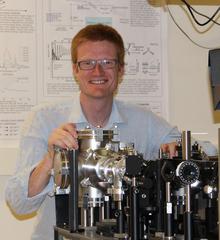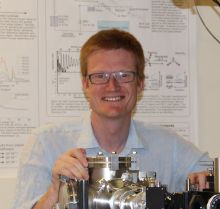URL: https://www.desy.de/news/news_search/index_eng.html
Breadcrumb Navigation
DESY News: Markus Gühr becomes Leading Scientist of FLASH
News
News from the DESY research centre
Markus Gühr becomes Leading Scientist of FLASH
On 1st October, Markus Gühr will start as Leading Scientist of the free-electron laser (FEL) FLASH. Jointly appointed with the Faculty of Chemistry at the University of Hamburg, the X-ray laser expert will then be in charge as a lead scientist at DESY and responsible for the fortunes of the world´s first SASE X-ray laser, which has been operating as a user facility since 2005 and is currently being made future-proof with the FLASH2020+ expansion project.

New head of FLASH: Markus Gühr. Photo: T. Wolf
After nine years at SLAC, during which he was also the spokesperson for LCLS experiments, Gühr returned to Germany in 2015 as a Volkswagen Foundation-funded Lichtenberg Professor at the University of Potsdam – his fascination with the research field continues. In a collaborative research project, his research group designed and built a sample chamber for FLASH and used it to measure ultrafast processes.
In his research, Markus Gühr is particularly fascinated by how molecules convert light from the sun into other forms of energy. “This is ultimately the basis of many of our raw materials,” he says. The molecules use very fast processes on the scale of a few femto- to picoseconds when converting solar energy. With their short pulses, free-electron lasers play an enormously important role in observing these processes. They can be used to trace the energy path through the molecule at atomic resolution.
These research questions will continue to accompany Gühr; now, he is moving to the centre of the action and starting as head of FLASH. And he wants to make a big difference with the facility: “The whole complexity of nature is just an interplay of nuclei, electrons and quantum mechanics – we want to make that visible with FLASH.” FLASH is ideal for observing the fast electrons interacting with each other and the nuclei in these processes. And with the FLASH2020+ project, the research potential improves even further. For example, the so-called seeding that will be incorporated in this project will improve the reproducibility and usability of the laser pulses in the experiment.
But in addition to science, Gühr now has many management tasks ahead of him. His goal: an FEL that attracts new user communities and generates an even higher scientific output. “By no means have we opened up all the scientific fields that benefit from free-electron lasers,” says Gühr. “Therefore, we want to actively attract new user communities for doing measurements here.” Regarding this, it might be pretty fortunate that he is based in the chemistry department at the University of Hamburg. He is also looking forward to teaching chemistry students.
And finally, according to Gühr, FLASH with its excellent team should continue to push the boundaries of what is feasible and conceivable, thus continuing to play in the top league of research in Europe and the world. To this end, he would like to make an active contribution himself, if time somehow permits, and experiment and research on FLASH – resonance included.




